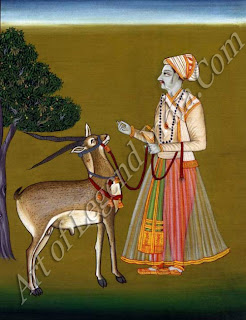 In
Tiruvannamalai, Tiruvottiyur, Tiruvalanjuli and other places, there are similar
representations of legends of Siva and scenes from the Ramayana and the
Mahabharata.
In
Tiruvannamalai, Tiruvottiyur, Tiruvalanjuli and other places, there are similar
representations of legends of Siva and scenes from the Ramayana and the
Mahabharata.
With the decline of the power of the
Vijayanagara memperors after the battle of Tallikota, the feudatory rulers
established themselves in independence with only a semblance of respect for the
titular emperor. At Madurai, Tirumala Nayak is reputed for his great patronage
of art, and the magnificent gopura and pudumandapa constructed by him are
famous. Similarly, in Tanjavur and Kumbakonam, Raghunatha Nayak of Tanjavur was
responsible for excellent monumental work. The temples of Minakshisundaresvara and
Alagar at Madurai, those of Tenkasi, Sankaranarayanarkoil, Perur and other
places are excellent examples of Nayak workmanship.
In the upper layer from the
Brihadisvara temple at Tanjavur covering the Chola one, there is a wealth of
Nayak painting particularly interesting from the point of view of the glimpse
it gives of life in the period with all the elaboration of costume,
ornamentation and other details, all easily gathered from this important and
elaborate series.
At Tiruparuttikunram and at Kanchipuram,
the Jain legends illustrating the lives of the Tirthankaras are portrayed with
greater vigour and here also the life of the period is very clearly depicted.
At Tiruvalur, the lilas of Siva are
represented on the ceiling of the mandapas in picturesque fashion with special
stress on the monkey-faced mythical king Muchukunda of the royal Chola family;
and, as legend would have it, it is he who brought the Sivalinga
enshrined at Tiruvalur as also the Somaskanda. The latter is amongst the most
famous early Chola bronzes.
 In
Tiruvannamalai, Tiruvottiyur, Tiruvalanjuli and other places, there are similar
representations of legends of Siva and scenes from the Ramayana and the
Mahabharata.
In
Tiruvannamalai, Tiruvottiyur, Tiruvalanjuli and other places, there are similar
representations of legends of Siva and scenes from the Ramayana and the
Mahabharata.
At
Chidambaram in the large andapa of the shrine of Sivakamasundari, there is a
magnificent series of paintings illustrating the story of Bhikshatana and
Mohini, the legends of Salva saints and the glory of Siva's dance.
The
Nayak period is also represented by several murals from Madurai here the
sixty-four lilas of Siva are epicted in picturesque panels narrating the story
graphically but many of them have been repainted and ruined.
There
are labels in Tamil or Telugu describing the themes of these paintings. In this
period, the nventionalization that set in during the Vijayanagara period is continued.
This stylisation, as already observed in sculpture, like the pointed nose,
fierce eyes, angular contours, limbs and so forth and peculiar arrangement of
garments on the body with patterns characteristic of the period, are all observed
in these paintings.
Writer - C. Sivaramamurti
Subscribe to:
Post Comments (Atom)












0 Response to "Nayak Emperor"
Post a Comment